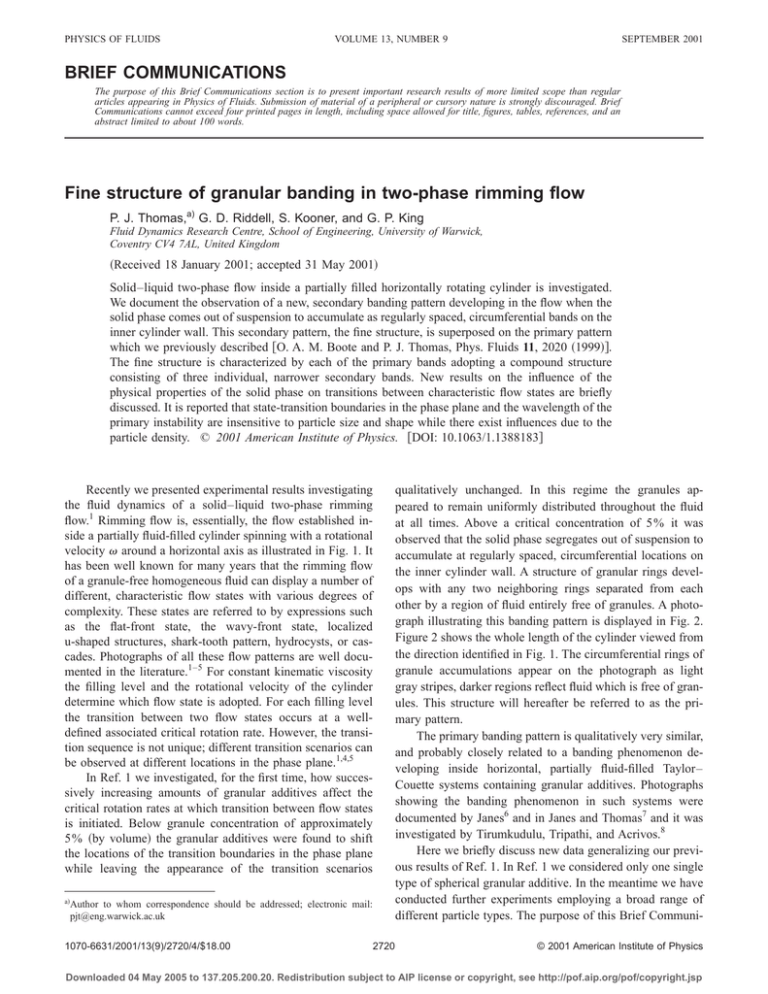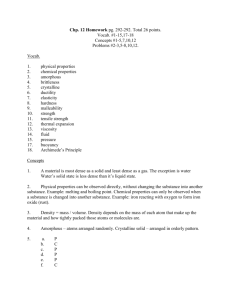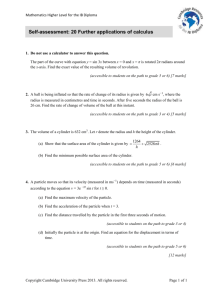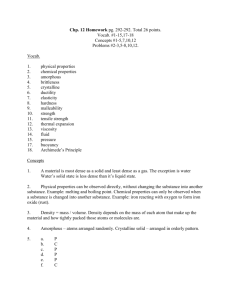Fine structure of granular banding in two-phase rimming flow
advertisement

PHYSICS OF FLUIDS VOLUME 13, NUMBER 9 SEPTEMBER 2001 BRIEF COMMUNICATIONS The purpose of this Brief Communications section is to present important research results of more limited scope than regular articles appearing in Physics of Fluids. Submission of material of a peripheral or cursory nature is strongly discouraged. Brief Communications cannot exceed four printed pages in length, including space allowed for title, figures, tables, references, and an abstract limited to about 100 words. Fine structure of granular banding in two-phase rimming flow P. J. Thomas,a) G. D. Riddell, S. Kooner, and G. P. King Fluid Dynamics Research Centre, School of Engineering, University of Warwick, Coventry CV4 7AL, United Kingdom 共Received 18 January 2001; accepted 31 May 2001兲 Solid–liquid two-phase flow inside a partially filled horizontally rotating cylinder is investigated. We document the observation of a new, secondary banding pattern developing in the flow when the solid phase comes out of suspension to accumulate as regularly spaced, circumferential bands on the inner cylinder wall. This secondary pattern, the fine structure, is superposed on the primary pattern which we previously described 关O. A. M. Boote and P. J. Thomas, Phys. Fluids 11, 2020 共1999兲兴. The fine structure is characterized by each of the primary bands adopting a compound structure consisting of three individual, narrower secondary bands. New results on the influence of the physical properties of the solid phase on transitions between characteristic flow states are briefly discussed. It is reported that state-transition boundaries in the phase plane and the wavelength of the primary instability are insensitive to particle size and shape while there exist influences due to the particle density. © 2001 American Institute of Physics. 关DOI: 10.1063/1.1388183兴 qualitatively unchanged. In this regime the granules appeared to remain uniformly distributed throughout the fluid at all times. Above a critical concentration of 5% it was observed that the solid phase segregates out of suspension to accumulate at regularly spaced, circumferential locations on the inner cylinder wall. A structure of granular rings develops with any two neighboring rings separated from each other by a region of fluid entirely free of granules. A photograph illustrating this banding pattern is displayed in Fig. 2. Figure 2 shows the whole length of the cylinder viewed from the direction identified in Fig. 1. The circumferential rings of granule accumulations appear on the photograph as light gray stripes, darker regions reflect fluid which is free of granules. This structure will hereafter be referred to as the primary pattern. The primary banding pattern is qualitatively very similar, and probably closely related to a banding phenomenon developing inside horizontal, partially fluid-filled Taylor– Couette systems containing granular additives. Photographs showing the banding phenomenon in such systems were documented by Janes6 and in Janes and Thomas7 and it was investigated by Tirumkudulu, Tripathi, and Acrivos.8 Here we briefly discuss new data generalizing our previous results of Ref. 1. In Ref. 1 we considered only one single type of spherical granular additive. In the meantime we have conducted further experiments employing a broad range of different particle types. The purpose of this Brief Communi- Recently we presented experimental results investigating the fluid dynamics of a solid–liquid two-phase rimming flow.1 Rimming flow is, essentially, the flow established inside a partially fluid-filled cylinder spinning with a rotational velocity around a horizontal axis as illustrated in Fig. 1. It has been well known for many years that the rimming flow of a granule-free homogeneous fluid can display a number of different, characteristic flow states with various degrees of complexity. These states are referred to by expressions such as the flat-front state, the wavy-front state, localized u-shaped structures, shark-tooth pattern, hydrocysts, or cascades. Photographs of all these flow patterns are well documented in the literature.1–5 For constant kinematic viscosity the filling level and the rotational velocity of the cylinder determine which flow state is adopted. For each filling level the transition between two flow states occurs at a welldefined associated critical rotation rate. However, the transition sequence is not unique; different transition scenarios can be observed at different locations in the phase plane.1,4,5 In Ref. 1 we investigated, for the first time, how successively increasing amounts of granular additives affect the critical rotation rates at which transition between flow states is initiated. Below granule concentration of approximately 5% 共by volume兲 the granular additives were found to shift the locations of the transition boundaries in the phase plane while leaving the appearance of the transition scenarios a兲 Author to whom correspondence should be addressed; electronic mail: pjt@eng.warwick.ac.uk 1070-6631/2001/13(9)/2720/4/$18.00 2720 © 2001 American Institute of Physics Downloaded 04 May 2005 to 137.205.200.20. Redistribution subject to AIP license or copyright, see http://pof.aip.org/pof/copyright.jsp Phys. Fluids, Vol. 13, No. 9, September 2001 Fine structure of granular banding 2721 FIG. 1. Sketch of the experimental setup. cation is, in particular, to document the observation of a striking, hitherto not observed, secondary granular-banding structure. Briefly, our experimental setup consists of a transparent, circular cylinder with a length l⫽27.0 cm and a radius r 0 ⫽5.00⫾0.01 cm. The cylinder is partially filled with silicone fluid 共Ambersil, F111/500兲 which has a kinematic viscosity of ⫽5.0 cm2 s⫺1 and a density of F ⫽0.973 g cm⫺3 . The cylinder is actuated by a variable speed motor via a belt drive as indicated in Fig. 1—for further details refer to Ref. 1. The granules used for the experiments described in Ref. 1 were spherical glass beads 共Potters–Ballotini兲 with a mean diameter of d G ⬇338 m and a density of G ⫽(2.500 ⫾0.003)⫻103 kg m⫺3 . The particles were, thus, significantly denser than the silicone carrier fluid. In the meantime we have carried out further experiments employing spherical granular additives with a wide range of different mean particle diameters (150 m⭐d G ⭐850 m兲 and densities (0.18 g cm⫺3 ⭐ G ⭐7.29 g cm⫺3 ). All experiments employing spherical particles were repeated for three different values of the amount m of granules added per cubic centimeter of silicone fluid. We have also tested samples of spherical additives comprising granules from two different size classes. Further we carried out experiments employing cylindrical nylon particles. The cylindrical particles had a diameter of 1 mm, a length of 5 mm, and a density of G ⫽1.14 g cm⫺3 . With respect to the location of the state transition boundaries in the phase plane our main new result is that the experiments employing different types of granular additives FIG. 2. Photograph showing the 共primary兲 granule-band structure which becomes clearly visible along the span of the cylinder for granule concentrations exceeding approximately 5% by volume. For the experiment shown here approximately m⫽0.33 g cm⫺3 of spherical glass beads with a mean diameter around d G ⬇338 m were added to the silicone fluid. The rotational velocity of the cylinder is ⫽1.68 rad s⫺1 and the pattern wavelength is ⬇2.3 cm. FIG. 3. Wavelength of the granule-band structure as a function of the nondimensional rotation rate * of the cylinder. All data points for which a mean diameter d G is stated in the legend were collected for spherical glass beads with a density of G ⫽2.500⫻103 kg m⫺3 . Due to the specific information provided by the manufacturer’s data sheet the diameter of the glass beads is approximate only. have shown that the boundaries appear to be insensitive to the granule size. Similarly, the wavelength of the primary banding pattern was found to be independent of the exact nature of the solid phase. Figure 3 displays as a function of the nondimensional cylinder rotation rate * defined as *⫽ r 0h . 共1兲 In Eq. 共1兲 the quantity h⫽V/2 r 0 l represents a measure for the mean thickness of the coating on the inner cylinder wall, where V is the total volume occupied by the fluid and the granules. The kinematic viscosity is the value stated by the manufacturer for the granule-free silicone fluid. Figure 3 reveals that the wavelength of the banding pattern does not depend on particle size, or on particle shape, or on the amount of granules added to the fluid. In order to support this result further, additional experiments were carried out with granule mixtures comprising two different size classes or, alternatively, mixtures of spherical and cylindrical particles. These experiments have reconfirmed that the wavelength does not depend on the particle properties. When granule mixtures were used the nature of the banding pattern remained unchanged. For the mixtures each of the primary bands contains granules of both particle classes. Nevertheless, the larger spheres were observed to accumulate in the central region of each band. Thus, this central portion of each band contains small as well as large spheres. The neighboring regions, left and right of the center of each band, only contain the smaller granules. Similarly, when mixtures of cylindrical and spherical particles were used the cylindrical particles occupied the central region of the bands. Note that this behavior is qualitatively different from the well-known phenomenon of axial segregation observed inside a horizontal rotating cylinder in purely granular flows, i.e., in the ab- Downloaded 04 May 2005 to 137.205.200.20. Redistribution subject to AIP license or copyright, see http://pof.aip.org/pof/copyright.jsp 2722 Phys. Fluids, Vol. 13, No. 9, September 2001 FIG. 4. Photograph showing the developed granular-banding fine structure along the whole length of the cylinder. The rotational velocity of the cylinder is of the order of ⬇8 rad s⫺1 . sence of a carrier fluid. In such purely granular flows mixtures containing spheres of two size classes segregate to form a series of bands with successive bands containing, alternatingly, large or small granules only.9 Hence, it can be speculated that the pattern wavelength observed here is selected as a consequence of the fluid properties and not as a consequence of the granular properties. The data spread in the direction of the ordinate of Fig. 3 increases for higher * . This is a consequence of the absolute uncertainty of, typically, ⫾1 for the number of bands resulting in larger relative errors for at higher * . Note, as yet there exists no explanation for the wavelength limit ⬇1.8 cm approached for * →0. While we could not measure influences of the particle size on the location of the state transition boundaries in the phase plane we did, nevertheless, measure effects due to the particle density. These effects will be the issue of a separate detailed discussion in due course. However, experiments employing particles with different densities revealed a striking new phenomenon associated with the primary banding pattern shown in Fig 2. Under appropriate conditions the primary pattern was observed to develop a secondary fine structure. Whenever the fine FIG. 5. Close up of two neighboring primary granular-banding structures each displaying a triplet fine structure. The rotational velocity of the cylinder is the same as in Fig. 4. Thomas et al. structure is present each of the relatively wide, primary granular rings shown in Fig. 2 has adopted a compound structure consisting of a set of narrower, secondary rings. The fine structure is illustrated in Figs. 4 and 5. Corresponding to Fig. 2 the photograph of Fig. 4 shows the whole length of the cylinder viewed from the direction indicated in Fig. 1. Figure 4 reveals that the prominent multiplicity of the compound rings is of order 3 by which each primary ring has, thus, adopted a triplet structure. Figure 5 shows a close-up view of two neighboring triplets. The wavy bright line running horizontally across the middle of the photograph reflects the contact line between the main pool of fluid inside the rotating cylinder and the wet inner cylinder surface. Thus, there are granules and fluid above and below the contact line. The total width of each primary, compound ring in Fig. 5 is approximately 20– 25 mm. The two primary structures are separated from each other by a region of granule-free fluid occupying a width of around 17 mm. Each secondary ring has a width of approximately 6 mm. The left and the right secondary ring of each primary structure are separated from the central secondary ring by an almost granule-free region with a width of around 2 – 3 mm. The main crests of the wavy contact line between the fluid and cylinder wall coincide with the middle of the central secondary ring of each triplet structure. To the left and to the right of the main crests weak secondary crests can be identified on the contact line. These secondary crests appear in the region occupied by the left and the right secondary side bands. The fine structure develops most pronounced for light, small particles. The granules used during the experiment shown in Figs. 4 and 5 were hollow glass spheres 共Sil-Cell兲 with a mean diameter of d G ⬇180 m and a density of G ⫽0.18 g cm⫺3 . Thus, the granule density is equal to approximately one-fifth of the density of the silicone fluid. For these particles the fine structure appeared clearly for particle concentrations below approximately 6% 共by volume兲. There are indications of the presence of the fine structure for small (d G ⬍338 m兲, heavier particles ( G ⫽2.5 g cm⫺3 ) at low particle concentrations. However, for these cases the fine structure was substantially less well developed. It only revealed itself as a faint variation of the particle concentration across the primary bands, rather than establishing welldefined secondary rings. We do not yet know whether the triplet fine structure is, in fact, the only possible stable fine structure or if there exist other fluid–granule combinations which would result in stable secondary banding patterns with higher multiplicity. Neither have we observed evidence of any tertiary structures by which the secondary bands itself would, possibly, show a hyperfine structure. We have observed structures which initially appeared to show more than three secondary bands. Nevertheless, the experiments have revealed that these structures, with such an apparently higher multiplicity, were transient. They usually formed, for instance, when two triplets merged to create a compound structure comprising five secondary granular rings. Such a merging process of two triplet structures can be identified in Fig. 4 approximately in the middle of the cylin- Downloaded 04 May 2005 to 137.205.200.20. Redistribution subject to AIP license or copyright, see http://pof.aip.org/pof/copyright.jsp Phys. Fluids, Vol. 13, No. 9, September 2001 der. However, the developing quintuplets are not stable and, after a few minutes, reseparate into two distinct triplets. Our experiments showed that the flow within the cusps of the wavy front, in the presence of granules but in the absence of granule bands, reflects the scenario illustrated by the sketch of Fig. 14共b兲 in Ref. 5. It is conceivable that the counterrotating vortices indicated in the sketch might give rise to the primary patterns. It is not obvious, however, how they could be connected with the emergence of the secondary pattern. In the presence of the fine structure the flow within the cusps is probably different from that illustrated by the sketch of Thoroddsen and Mahadevan in Ref. 5. In fact, in Ref. 1 we pointed out that the wavy-front state in the absence of any granule-band formation might be an altogether different state than the wavy front when granule bands are present. Recently Tirumkudulu et al.10 have referred to this and they concluded that their latest experimental results support this view. When granule bands are present the particles no longer act as clear tracers visualizing the flow field. Hence, we are presently unable to comment on the nature of the flow within the cusps or between successive granule bands. We believe that the formation of the primary granular bands probably has to be attributed to a process referred to as shear induced diffusion.1,8,10,11 By this process particles are assumed to migrate from regions of high shear to regions with low shear and from regions with high particle concen- Fine structure of granular banding 2723 trations to regions with low concentrations. Although it appears likely that the fine structure has a similar origin we do not yet know which parameters govern its properties. 1 O. A. M. Boote and P. J. Thomas, ‘‘Effects of granular additives on transition boundaries between flow states of rimming flows,’’ Phys. Fluids 11, 2020 共1999兲. 2 R. T. Balmer, ‘‘The hydrocyst—A stability phenomenon in continuum mechanics,’’ Nature 共London兲 227, 600 共1970兲. 3 M. J. Karweit and S. Corrsin, ‘‘Observations of cellular patterns in a partly filled, horizontal, rotating cylinder,’’ Phys. Fluids 18, 111 共1975兲. 4 F. Melo, ‘‘Localized states in a film-dragging experiment,’’ Phys. Rev. E 48, 2704 共1993兲. 5 S. T. Thoroddsen and L. Mahadevan, ‘‘Experimental study of coating flows in a partially-filled horizontal rotating cylinder,’’ Exp. Fluids 23, 1 共1997兲. 6 D. A. Janes, ‘‘A bioreactor for delicate biomaterials: Physical and process factors in plant biotechnology,’’ Ph.D. dissertation, Department of Chemical Engineering, University of Birmingham, 1988. 7 D. A. Janes and N. H. Thomas, ‘‘On particle motions within rotating flow annular vessels,’’ in Proceedings of the Symposium of Fluid Mixing IV, organized by I. Chem. E., University of Bradford, England, 11–13 September 1990. 8 M. Tirumkudulu, A. Tripathi, and A. Acrivos, ‘‘Particle segregation in monodisperse sheared suspensions,’’ Phys. Fluids 11, 507 共1999兲. 9 J. Duran, Sands, Powders and Grains—An Introduction to the Physics of Granular Materials 共Springer, New York, 1999兲. 10 M. Tirumkudulu, A. Mileo, and A. Acrivos, ‘‘Particle segregation in monodisperse sheared suspensions in a partially filled rotating cylinder,’’ Phys. Fluids 12, 1615 共2000兲. 11 D. Leighton and A. Acrivos, ‘‘The shear-induced migration of particles in concentrated suspensions,’’ J. Fluid Mech. 177, 109 共1987兲. Downloaded 04 May 2005 to 137.205.200.20. Redistribution subject to AIP license or copyright, see http://pof.aip.org/pof/copyright.jsp




